Native Son – February, 2013
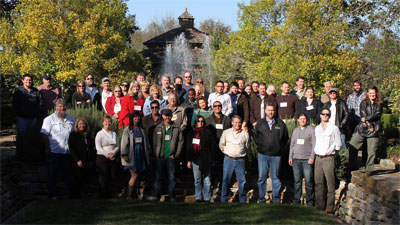
TABGA members assembled in North Texas for their 2013 meeting. Photo courtesy of Zoe Rascoe.
Kickin’ the Blues
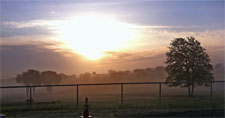
Maybe the early-morning meadows hold an answer.
So I’m sitting here all glazed over and strung out from hosting the 2013 Texas Association of Botanical Gardens and Arboreta (TABGA) annual meeting, trying to get inspired to write something. Some days, I just don’t think I have it in me … and this is one of those days. It suddenly occurs to me that if the answer is not from within, perhaps it is from without, so I head off into the “back 40” to see if I can rustle something up from the dormant meadows.
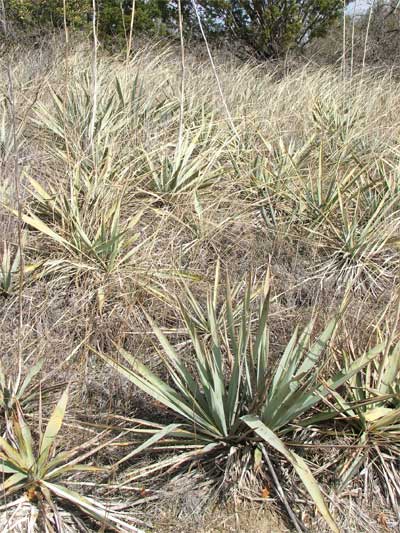
The prairie remnant with colonies of pallid yucca. Photos courtesy of Steven Chamblee.
I cut across a path that I used to keep maintained through the pallid yuccas (botanically named Yucca pallida … isn’t that handy?). They are a bit bleached out, like they always get in the winter, but I love them for it because I get to watch them green up as the soil temperatures rise in spring.
Geesh, a little time passes and the path becomes almost invisible. That great line from Ralph Waldo Emerson comes to mind … “Go often to the house of thy friend, for weeds choke the unused path.” This gets me to thinking about friends I haven’t seen in ages, and soon enough, I am lost in thought, forgetting about my “mission” to discover something. I am happy in the moment, and have forgotten also that my tardiness is causing heartburn for the folks back at the Sperry office.
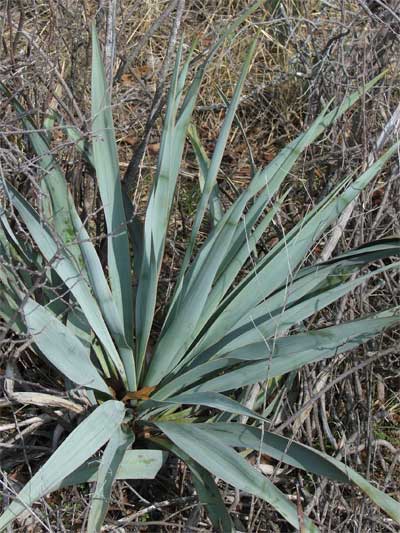
The blue pallid yucca.
I round a slight bend in the path, and stop short at the sight in front of me. There, amid the sea of pale green leaves of the pallid yuccas, is a small population of pale blue pallid yuccas. My spine jerks me upright, and I feel that groovalicious feeling that I’m sure Greg Grant feels when he encounters something special. Wow … I’ve seen thousands of these plants, tens of thousands of these plants, and I’ve never seen a blue one. But there they are, five of them, clustered in a tiny spot out in this meadow.
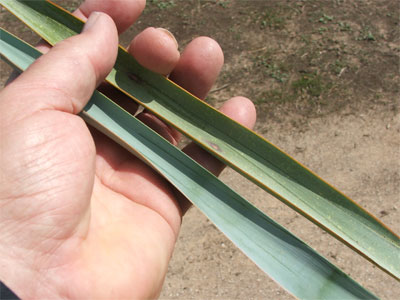
Comparing the leaves of the blue and a typical pallid yucca.
I get all excited and start thinking of names for them … “The Blues Brothers” … “Blues Power” … “Texas Blue.” This soon leads to Stevie Ray Vaughn’s guitar ripping through my brain, and I start whipping out some bodacious lyrics: “I got those low down, dirty dog, gutter-grindin’, side-windin’, mind-blindin’, trash-haulin’, butter-ballin’, steam-rollin’, bad colon, rain poundin’, pain houndin’ (bahmp, bahmp, bahmp) blue yucca baa-loooooo-hoooos!” As I arch back, sending this bad boy song upward to the heavens, I notice the vultures circling above … seems my version of the blues sounds like impending death to them. Oddly enough, the people at my 50th birthday bash said the same thing of my Elvis impression. (Poor souls didn’t have enough tequila to appreciate my virtuosity.)
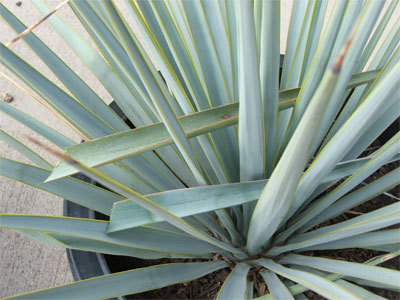
Comparing leaves of typical and blue pallid yucca (Yucca pallida) with the Blue Yucca (Yucca rigida).
My rare native prairie remnant happy dance is suddenly interrupted by the thought that I must now keep this a secret. If word gets out, some selfish fool will come and dig not one, but all of them up. Such is the nature of greed. (I am reminded of the gigantic, old-growth pines that once blanketed the American South, and how they are completely gone now.) I suppose the only real answer lies in separation and secrecy. Those folks in the TABGA understand my plight, and can help me preserve this sweet little anomaly that Mother Nature produced and presented to me. Perhaps with a little selective breeding and a touch of micropropagation, it can live on. Maybe this little treasure that I found on the path less taken will somehow lead me down a new path … a path to more discoveries.
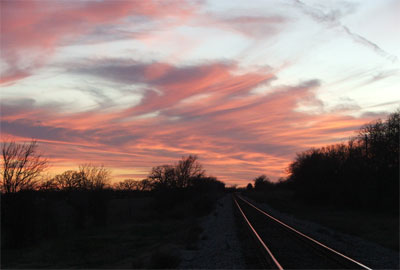
You never know what will happen when you take a walk outside.
Hmmm … it’s kind of amazing what can happen when you just get outside and go for a walk. I highly recommend it.
For more information about TABGA, click here.
About the author: Steven Chamblee is the chief horticulturist for Chandor Gardens in Weatherford and a regular contributor to Neil Sperry’s GARDENS magazine and e-gardens newsletter. Steven adds these notes:
Bulbs and a few precocious azaleas are poppin’! Come and watch spring come alive at Chandor Gardens. Just take I-20 west to exit 409, hang a right, go 2.1 miles and hang a left on Lee Avenue. Head straight 12 blocks and you’re driving in the gates. Call 817-361-1700 for more information. You can always go to www.chandorgardens.com for a picture tour and details.
I can always use another road trip! Let me know if you’d like me to come out and speak to your group sometime. I’m low-maintenance, flexible, and you know I like to go just about anywhere. No city too big; no town too small. Just send me an e-mail at schamblee@weatherfordtx.gov and we’ll work something out.
